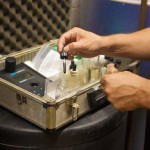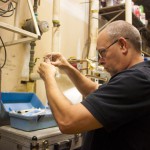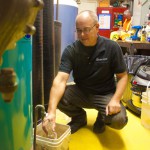A device that reduces water hardness using ion exchange resin to replace calcium, magnesium, and other hardness ions with sodium. Normally regenerated with salt. Produces water with greater sudsing power (soap saver) and reduces staining of porcelain fixtures, and enhances cleaning ability. A water softener will remove clear water (ferrous) iron and manganese at lower levels. Ferric iron (rust) can foul a water softener. For removal of ferric iron, or for the removal of high levels of iron and / or manganese, an iron filter or chemical injection system may be required.
A device for removing impurities from a fluid, usually using a physical barrier, often a filter cartridge. Examples include carbon filters for removing taste and odour, self-cleaning sand filters to reduce turbidity, sediment filters with blow down capability, and sophisticated reverse osmosis filters which use semi-permeable membranes capable of filtration on the molecular level.
A method of water purification using ultra violet light, normally produced by a mercury vapour lamp, to kill micro organisms and pathogens without the use of chemicals. Does not affect the taste, odour or colour of the water . Effective against crypto cryptosporidium, giardia (beaver fever). Water must be pre-filtered to remove particles larger than 5 micron. The UV transmittance of the water (loosely inversely related to the turbidity) must be high enough order for UV disinfection to be effective.
The removal of contaminants from water by forcing the water through a semi-permeable membrane, which allows small molecules, such as water, to pass but blocks larger molecules such as sodium, resulting in purer water. Note that although RO removes may pathogens such as bacteria due to their size, it is not a reliable method of water disinfection.
The UV lamp provides the disinfection and must be replaced on either an annual (residential units) or bi-annual (commercial units) basis. The sleeve is the window through which the UV light passes to get to the water and as such, must be kept clean. It is recommended that the sleeve be cleaned every time the lamp is changed, and replaced if it cannot be cleaned due to excess fouling.
Iron filters remove iron and manganese without the need to regenerate with salt. Some also remove hydrogen sulfide, the gas that produces the "rotten egg" smell. They are effective in removing iron in its clear water, or ferrous state, as well as in the rust, or ferric state. Iron that is in the ferric or rust state can foul a water softener. Iron filters do not reduce water hardness.
The Water Shop can supply consumable products for the testing of water such as reagents for testing chlorine, etc.
Extreme water conditions that cannot be corrected with conventional equipment such as a water softener or an iron filter may require a chemical injection system. A typical system is comprised of a solution tank, a chemical pump, an injector, a retention tank, and one or more filters to remove contaminants. Chemicals commonly injected are either oxidants such as chlorine or coagulant such as alum.
A tanin filter is similar to a water softener, but uses different media so that it can remove tanins and lignins, which are not removed by a regular water softener. Tanins are fulvic or humic acids which can make water yellow or brown, stain clothing and fixtures, and impart a tangy aftertaste and / or earthy, fishy or musty odour. A tanin filter regenerates with the same salt as a water softener.
A calcite filter contains a sacrificial media, calcium carbonate, which will treat acidic water, giving it a pH that is more neutral, reducing the blue-green copper stain on fixtures, and / or making RO water less aggressive. These filters must be topped up once a year and can be self cleaning if required due to water conditions.




